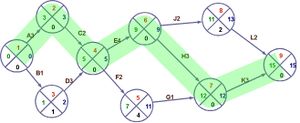Network charts
Network charts is a group of methods developed in the late 50's and 60 projects for the defense industry of the United States. Despite its age, they are still widely used. Two of the most famous network charts are:
- CPM - Critical Path Method
- PERT - Program Evaluation and Review Technique
The basic principle underlying the design of network charts is possible existence of simultaneous tasks that are not dependent on each other. This results in significant time savings. Most of the modern software used for project management draws network charts.
Procedure for creating network chart
- split project into tasks and activities
- determine the logical consequences of particular tasks and activities
- estimate duration of each action/task
- put all tasks on network graph
- determine the earliest possible and of latest allowable times of occurrence of each task
- calculate time reserves for each task
- determine critical path of tasks without time reserves
- improve network of tasks by shortening the critical path
Principles of constructing network charts
- first task do not have prior activity
- final task do not have steps after it
- every diagram have initial and final event and all the activities connecting then
- event can not take place until the end in all the steps leading to it
- subsequent task can not begin until an event occurs
- between the two events may be only one action plotted
- vectors of tasks should be directed from left to right
- intersections of vectors should be avoided
- network diagram branches out in the direction of operations from left to right
- network diagram should not have closed circuits, i.e. the loop connecting twice the same events
- each network diagram should be agreed with the responsible contractors
- check the order of operations, accuracy of links (parallel activities), and then perform the calculation of the duration of the entire project, slack time and mark a critical path.
Basic concepts
- task - action with specified time (having the duration). CPM diagram indicates it is an arrow, while in PERT it is a rectangle
- event - the moment of the end or the start of operations. It is a point of time therefore does not have its time dimension. On CPM charts it is marked as a circle divided into 4 parts. In the upper part is the sequence number, on the left of the earliest possible date, on the right of latest permissible date, at the bottom the reserve of time is indicated.
- critical path - the path from the first to the last event with all subsequent events and activities having a zero reserve of time.
- earliest possible date of occurrence - maximum value according to the principle that an event can occur when previously completed all the steps preceding it. For the first event value is "0".
- latest permissible date of occurrence
- reserve time - equal to the difference between latest permissible date of occurrence and earliest possible date of occurrence. Sequence of activities for which time reserve is "0" is called Critical Path.
Advantages of network charts
Application of the network charts allows to:
- reduce the duration of the project without any additional organizational changes and expenditures
- reduce the overall costs of design and implementation of complex changes
- increase rational use of time reserves
- focus attention on activities critical to the entire project
- facilitate planning and setting realistic deadlines for completion
- create a basis for checking the progress of work in efficient way
Critical path method CPM
This method was developed in 1956-1957 in the United States by Du Pont de Nemours & Co. It was used to manage the maintenance of the equipment and bring order to the organization, which had lead to an increase in the efficiency of the company. There is no clearly defined method of presentation of the network chart for the critical path method. To be able to use the method CPM it is necessary to have data on the duration of individual actions. CPM method is designed to determine the overall execution time or date of completion of the project.
PERT - Program Evaluation and Review Technique
PERT method was created in 1958 in the United States by mathematicians working with the US Office of Naval Systems. PERT method is used for unique operations. It is a stochastic model, because the duration of individual actions is not determined exactly, only with a certain probability. This makes it easier to apply but only using the appropriate computer program due to high complexity of calculations. In PERT method, to each step we assign four time estimates: the optimistic, most likely, pessimistic and expected.
References
- Anderson, E. B., & Hales, R. S. (1986). Critical path method applied to research project planning: Fire Economics Evaluation System (FEES). Gen. Tech. Rep. PSW-93. Berkeley, Calif.: Pacific Southwest Research Station, Forest Service, US Department of Agriculture. 12 p, 93.
- Tamrakar, P. (2013). Analysis and Improvement by the Application of Network Analysis (Pert/Cpm). The International Journal of Engineering and Science, 2(1), 154-159.
- Yamin, R. A., & Harmelink, D. J. (2001). Comparison of linear scheduling model (LSM) and critical path method (CPM). Journal of Construction Engineering and Management, 127(5), 374-381.
